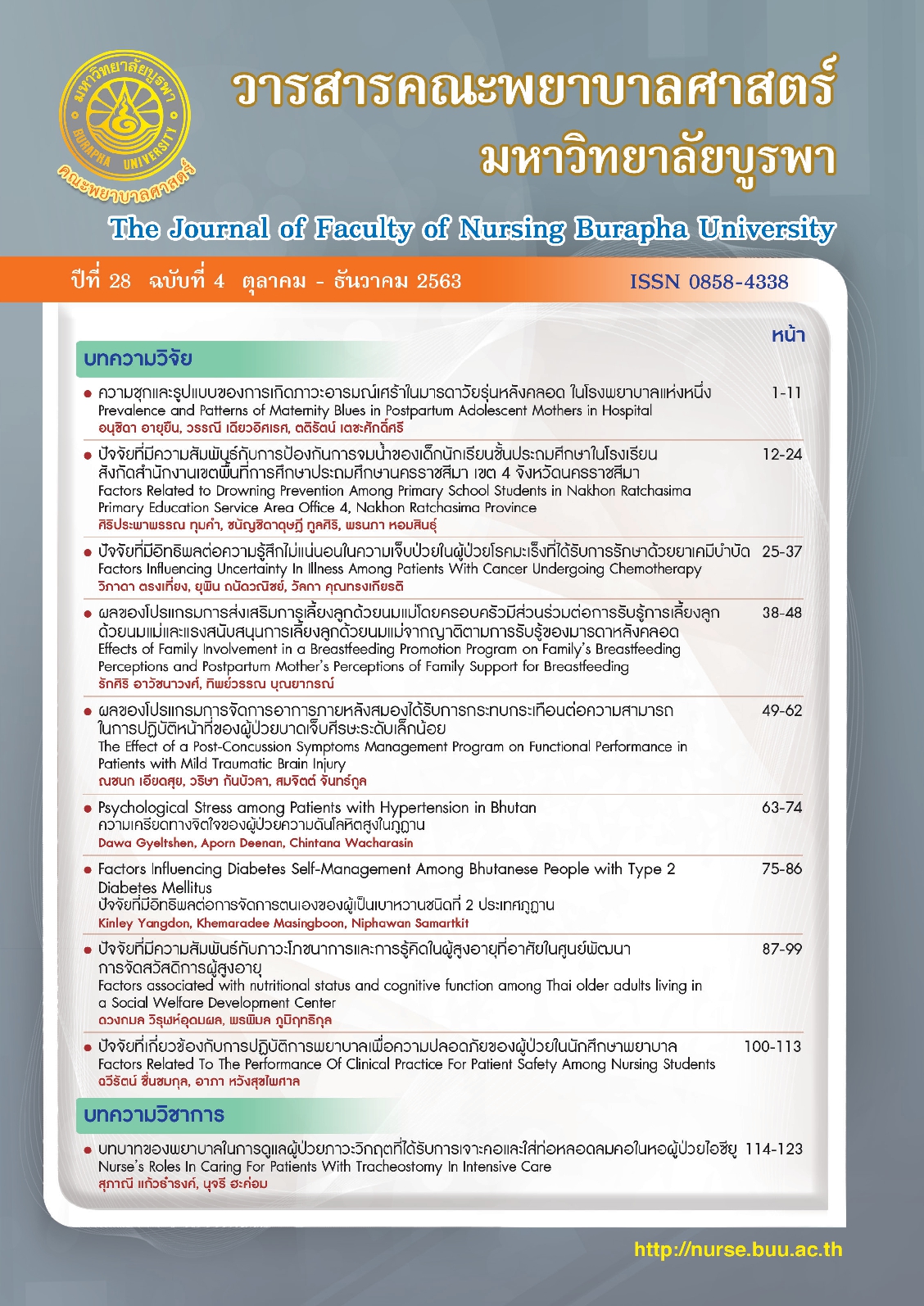ความเครียดทางจิตใจของผู้ป่วยความดันโลหิตสูงในภูฏาน
คำสำคัญ:
ประวัติโรคความดันโลหิตสูงในครอบครัว, ระยะเวลาที่เป็นโรคความดันโลหิตสูง, การควบคุมความดันโลหิต, โรคความดันโลหิตสูงบทคัดย่อ
ความเข้าใจเกี่ยวกับความเครียดที่มีผลต่อการควบคุมความดันโลหิตสูงเป็นสิ่งสำคัญในการช่วยเหลือให้ผู้ป่วยโรคความดันโลหิตสูงสามารถควบคุมความดันโลหิตได้ การศึกษาครั้งนี้มีวัตถุประสงค์เพื่อศึกษาระดับความเครียดของผู้ป่วยโรคความดันโลหิตสูงและศึกษาความแตกต่างของระดับความเครียดตามปัจจัยที่มีผลต่อความเครียดในผู้ป่วยโรคความดันโลหิตสูง ได้แก่ เพศ ประวัติโรคความดันโลหิตสูงในครอบครัว การควบคุมความดันโลหิต ระยะเวลาที่เป็นโรคความดันโลหิต กลุ่มตัวอย่างในการวิจัยเชิงพรรณาครั้งนี้ ได้แก่ ผู้ป่วยโรคความดันโลหิตสูง จำนวน 120 คน ที่ได้จากการสุ่มตัวอย่างอย่างง่าย จากผู้ที่มารับบริการที่โรงพยาบาลแห่งชาติจิกมี ดอจิ วังชุก ประเทศภูฏาน รวบรวมข้อมูลโดยใช้แบบสอบถามข้อมูลทั่วไปและแบบสอบถามการรับรู้เกี่ยวกับความเครียด วิเคราะห์ข้อมูลโดยสถิติพรรณาและการทดสอบค่าที (t-test)
ผลการศึกษาพบว่ากลุ่มตัวอย่างส่วนใหญ่ ร้อยละ 75.8 มีความเครียดระดับปานกลาง (x̄ =20.2, SD =5.6) กลุ่มตัวอย่างร้อยละ 12.5 มีความเครียดอยู่ในระดับสูง ขณะที่กลุ่มตัวอย่างเพียงร้อยละ 11.7 มีความเครียดระดับต่ำ ผลการทดสอบความแตกต่างของปัจจัยที่เกี่ยวข้องกับความเครียด พบว่า กลุ่มตัวอย่างมีความเครียดแตกต่างกันในคนที่มีและไม่มีประวัติครอบครัวเป็นโรคความดันโลหิตสูง (t118 = 2.18, p <.05) ผู้ที่ควบคุมความดันโลหิตได้และไม่ได้ (t118 = -2.42, p <.05) ระยะเวลาที่เป็นโรคความดันโลหิตสูงมากและน้อยกว่า 60 เดือน (t118 = -4.21, p <.001) แต่ไม่พบความแตกต่างระหว่างเพศหญิงและเพศชาย (t118 = 1.85, p >.05) ข้อเสนอแนะจากการวิจัยครั้งนี้ ได้แก่ การพัฒนาวิธีการจัดการความเครียดสำหรับผู้ป่วยโรคความดันโลหิตสูงในภูฏานโดยคำนึงถึงระยะเวลาที่เป็นโรคความดันโลหิตสูง ประวัติโรคความดันโลหิตสูงในครอบครัวความสามารถในการควบคุมความดันโลหิต
เอกสารอ้างอิง
Chamik, T., Viswanathan, B., Gedeon, J., & Bovet, P. (2018). Associations between psychological stress and smoking, drinking, obesity, and high blood pressure in an upper middle‐income country in the African region. Stress and Health, 34(1), 93-101.
Cohen, S., Kamarck, T., & Mermelstein, R. (1983). A global measure of perceived stress. Journal of health and social behavior, 24(4),385-396.
Duwe, E. A., Holloway, B. M., Chin, J., & Morrow, D. G. (2018). Illness experience and illness representation among older adults with hypertension. Health Education Journal, 77(4), 412-429.
Gallo, L. C., Roesch, S. C., Fortmann, A. L., Carnethon, M. R., Penedo, F. J., Perreira, K., . . . Talavera, G. A. (2014). Associations of chronic stress burden, perceived stress, and traumatic stress with cardiovascular disease prevalence and risk factors in the HCHS/SOL sociocultural ancillary study. Psychosomatic Medicine, 76(6), 468-475.
Hsiao, C.-Y., Chang, C., & Chen, C.-D. (2012). An investigation on illness perception and adherence among hypertensive patients. The Kaohsiung journal of medical sciences, 28(8), 442-447.
Inoue, N. (2014). Stress and atherosclerotic cardiovascular disease. Journal of atherosclerosis and thrombosis, 21(5), 391-401.
Kibler, J. L., Joshi, K., & Ma, M. (2009). Hypertension in relation to posttraumatic stress disorder and depression in the US National Comorbidity Survey. Behavioral Medicine, 34(4), 125-132.
Kim, K.-B., Lee, J. H., Lee, Y., Noh, J.-W., & Kwon, Y. D. (2018). Factors affecting level of perceived stress by gender. The Journal of the Korea Contents Association, 18(3), 235-245.
Liu, M.-Y., Li, N., Li, W. A., & Khan, H. (2017). Association between psychosocial stress and hypertension: a systematic review and meta-analysis. Neurological research, 39(6), 573-580.
Malan, L., Schutte, C. E., Alkerwi, A. a., Stranges, S., & Malan, N. T. (2017). Hypothalamic-pituitary-adrenal-axis dysregulation and double product increases potentiate ischemic heart disease risk in a Black male cohort: the SABPA study. Hypertension Research, 40(6), 590-597.
Milas, G., Klarić, I. M., Malnar, A., Šupe‐Domić, D., & Slavich, G. M. (2019). Socioeconomic status, social‐cultural values, life stress, and health behaviors in a national sample of adolescents. Stress and Health, 35(2), 217-224.
O'Donnell, M. J., Chin, S. L., Rangarajan, S., Xavier, D., Liu, L., Zhang, H., . . . Agapay, S. (2016). Global and regional effects of potentially modifiable risk factors associated with acute stroke in 32 countries (INTERSTROKE): a case-control study. The Lancet, 388(10046), 761-775.
Richardson, S., Shaffer, J. A., Falzon, L., Krupka, D., Davidson, K. W., & Edmondson, D. (2012). Meta-analysis of perceived stress and its association with incident coronary heart disease. The American journal of cardiology, 110(12), 1711-1716.
Rothwell, P. M., Howard, S. C., Dolan, E., O'Brien, E., Dobson, J. E., Dahlöf, B., . . . Poulter, N. R. (2010). Prognostic significance of visit-to-visit variability, maximum systolic blood pressure, and episodic hypertension. The Lancet, 375(9718), 895-905.
Sadeghi, M., Alavi, M., Mohammadi, M., Roohafza, H., Mahmoodi, A., Visentin, D., . . . Cleary, M. (2019). Perceptions of illness as predictive factors for perceived stress in patients participating in a cardiac rehabilitation program. Nursing & health sciences. 21(4), 508-514.
Sarkar, A., Roy, D., Chauhan, M. M., Dave, P., Makwana, N. R., & Parmar, D. V. (2019). A lay epidemiological study on coexistent stress in hypertension: Its prevalence, risk factors, and implications in patients’ lives. Journal of Family Medicine and Primary Care, 8(3), 966-971.
Vasunilashorn, S., Lynch, S. M., Glei, D. A., Weinstein, M., & Goldman, N. (2015). Exposure to stressors and trajectories of perceived stress among older adults. Journals of Gerontology Series B: Psychological Sciences and Social Sciences, 70(2), 329-337.
Verma, R., & Ura, K. (2018). Gender differences in Gross National Happiness in Bhutan: abridged analysis of the GNH surveys. GNH: From Philosophy to Praxis, Proceedings of the sixth international conference on GNH, 4-6 November 2015, Paro, Bhutan, 196-247.
Wang, J., Ma, J. J., Liu, J., Zeng, D. D., Song, C., & Cao, Z. (2017). Prevalence and risk factors of comorbidities among hypertensive patients in China. International journal of medical sciences, 14(3), 201-212
World Health Organization (2019). Hypertension factsheet. Retrieved from https://www.who.int/news-room/fact-sheets/detail/hypertension
World Health Organization (2016). National survey for noncommunicable disease risk factors and mental health using WHO STEPS approach in Bhutan-2014. Retrieved from http://apps.who.int/iris/handle/10665/204659





